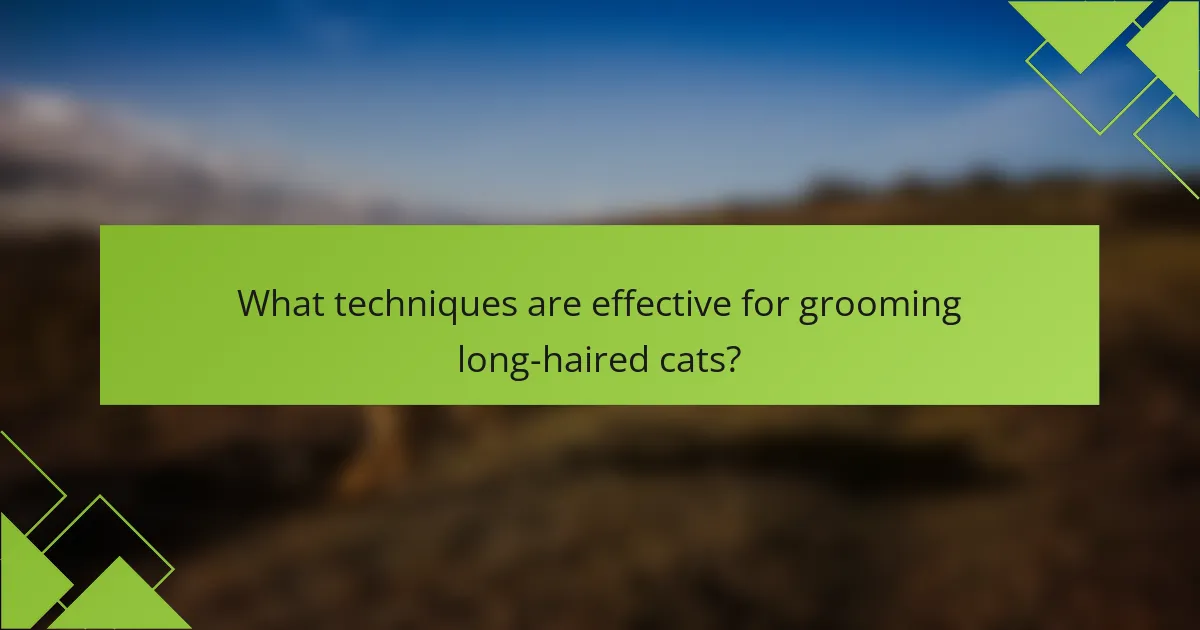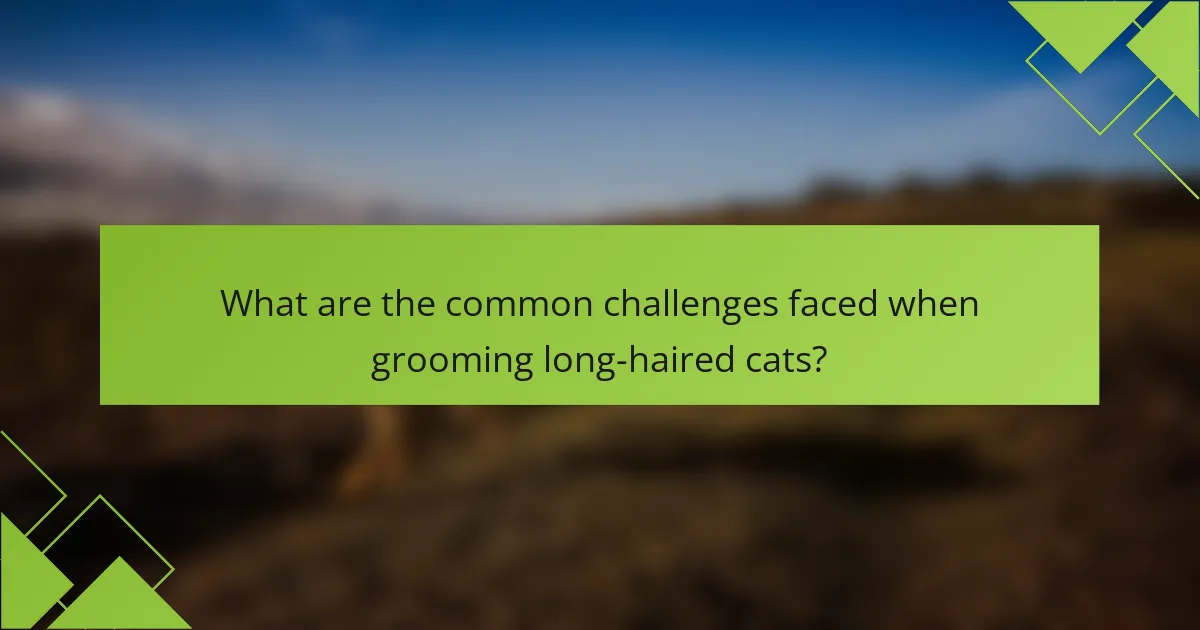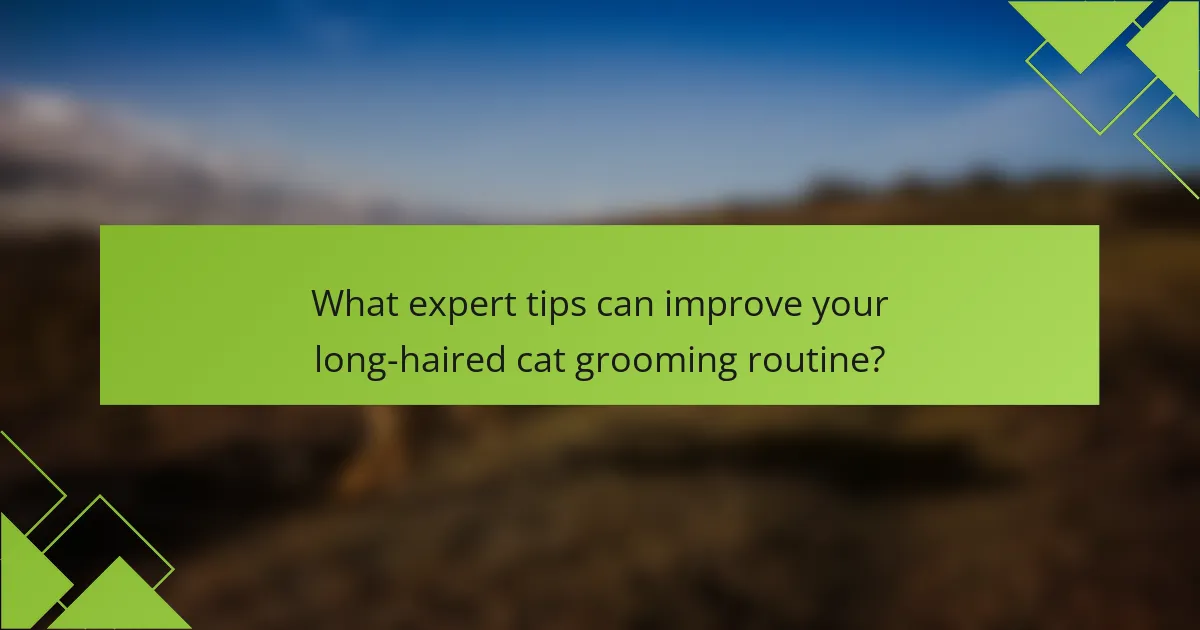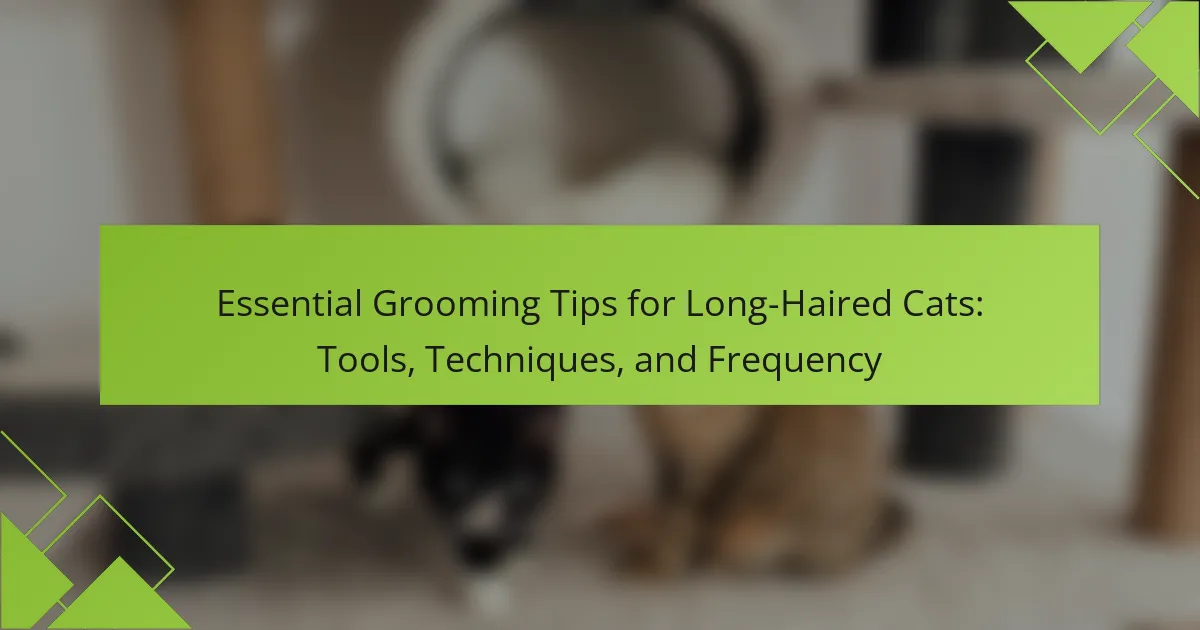Grooming long-haired cats is essential for their comfort and health. This article covers the necessary tools, effective techniques, and recommended grooming frequency. Discover how to prevent matting, reduce shedding, and maintain a shiny coat. Establishing a consistent grooming routine can enhance your cat’s well-being and strengthen your bond.

What are the essential grooming tools for long-haired cats?
Essential grooming tools for long-haired cats include a slicker brush, a wide-toothed comb, nail clippers, and grooming gloves. These tools help prevent matting, reduce shedding, and maintain a healthy coat. Regular grooming with these tools enhances the cat’s comfort and overall well-being.
How do different brushes and combs affect grooming efficiency?
Different brushes and combs significantly influence grooming efficiency for long-haired cats. The right tool reduces mats, minimizes shedding, and enhances coat health.
Slicker brushes effectively remove tangles and loose fur, making them ideal for long-haired breeds. Wide-toothed combs detangle without pulling, ensuring comfort during grooming. Bristle brushes distribute natural oils, promoting a shiny coat. Regular use of these tools can significantly decrease grooming time and improve overall grooming results.
Which clippers and scissors are recommended for long-haired breeds?
For long-haired breeds, recommended clippers include the Wahl Bravura and Andis ProClip, while scissors like the Geib Gator and Wahl Arco are ideal for precision. These tools ensure effective grooming with minimal stress. Clippers should have adjustable speed settings, while scissors must feature sharp, curved blades for easy maneuverability. Regular grooming with the right tools prevents matting and promotes healthy fur.
What grooming products are beneficial for maintaining coat health?
Grooming products that benefit long-haired cats include high-quality brushes, combs, and specialized shampoos. Regular use of these tools helps prevent matting, reduces shedding, and maintains skin health.
1. Slicker brushes | Remove loose fur and prevent tangles.
2. Wide-tooth combs | Detangle knots without damaging hair.
3. Cat-specific shampoos | Cleanse without stripping natural oils.
4. De-shedding tools | Minimize shedding and hairballs.
5. Nail clippers | Maintain paw health and prevent injury.
6. Ear cleaners | Keep ears free from wax and debris.

What techniques are effective for grooming long-haired cats?
Effective techniques for grooming long-haired cats include regular brushing, bathing, and nail trimming. These methods help prevent matting and keep their coat healthy.
1. Brush daily to remove loose hair and prevent tangles.
2. Use a wide-toothed comb for detangling and a slicker brush for smooth finishing.
3. Bathe every few months with cat-specific shampoo to maintain coat cleanliness.
4. Trim nails every 2-4 weeks to prevent overgrowth and injury.
These grooming practices enhance the cat’s appearance and overall well-being.
How can you safely detangle matted fur?
To safely detangle matted fur, use a wide-toothed comb and start from the tips, working your way up. Apply a detangling spray or conditioner to ease the process. Gently separate small sections of fur, holding the base to minimize pulling on the skin. Regular grooming every few days can prevent mats from forming.
What are the best practices for bathing long-haired cats?
Bathing long-haired cats requires careful preparation and technique. Use a gentle cat shampoo and ensure the water is warm but not hot. Start by brushing the cat thoroughly to remove tangles and loose fur. Wet the cat gradually, avoiding the head initially, to minimize stress. Apply shampoo, lather, and rinse thoroughly to prevent residue. Dry the cat with a towel and use a blow dryer on a low setting if the cat tolerates it. Aim to bathe every 4 to 6 weeks to keep their coat clean and healthy.
How to trim a long-haired cat’s fur without causing stress?
To trim a long-haired cat’s fur without causing stress, use calming techniques and appropriate tools. Begin by selecting a quiet environment to minimize distractions.
1. Gather tools: Use a high-quality comb, scissors, and grooming clippers designed for pets.
2. Introduce the tools gradually: Allow your cat to sniff and explore the tools before starting the grooming session.
3. Use positive reinforcement: Reward your cat with treats and praise during and after grooming to create a positive association.
4. Trim in small sections: Work slowly and carefully, focusing on one area at a time to avoid overwhelming your cat.
5. Monitor your cat’s comfort: Watch for signs of stress, such as twitching or vocalizing, and take breaks if needed.
By following these steps, you can effectively groom your long-haired cat while minimizing anxiety.

How often should you groom long-haired cats?
Groom long-haired cats at least two to three times a week to prevent matting and reduce shedding. Regular grooming helps maintain coat health and minimizes hairballs. Use a wide-toothed comb and slicker brush for effective detangling. Adjust frequency based on the cat’s coat condition and lifestyle.
What factors influence grooming frequency for different breeds?
Grooming frequency varies by breed due to coat type, shedding patterns, and skin health. Long-haired cats typically require more frequent grooming than short-haired breeds.
Factors influencing grooming frequency include:
– Coat Density: Dense coats trap dirt and mats, requiring more frequent grooming.
– Shedding Patterns: Breeds that shed heavily may need regular grooming to manage loose fur.
– Skin Health: Some breeds are prone to skin issues, necessitating more frequent grooming to maintain skin condition.
– Lifestyle: Indoor cats may require less grooming than outdoor cats due to less exposure to dirt and debris.
– Owner’s Preference: Some owners choose to groom more frequently for aesthetic reasons or to strengthen the bond with their pet.
How does seasonal shedding affect grooming routines?
Seasonal shedding significantly impacts grooming routines for long-haired cats. Increased shedding during specific seasons necessitates more frequent brushing to manage loose fur and reduce matting.
During shedding periods, daily grooming is recommended to maintain coat health and minimize hairballs. Essential tools include a slicker brush and a wide-toothed comb, which help remove loose hair and prevent tangles.
Regular grooming not only keeps the coat clean but also enhances the bond between the cat and owner. Adjusting the grooming routine according to shedding cycles ensures a healthier and more comfortable experience for the cat.

What are the common challenges faced when grooming long-haired cats?
Common challenges when grooming long-haired cats include matting, shedding, and skin sensitivity. Regular grooming helps prevent tangles and maintains coat health. Long-haired cats require specific tools like slicker brushes and combs to manage their unique fur texture. Additionally, some cats may resist grooming, making the process more difficult. Establishing a routine can ease anxiety and improve cooperation.
How to manage a cat’s anxiety during grooming sessions?
To manage a cat’s anxiety during grooming sessions, create a calm environment and use positive reinforcement. Gradually introduce grooming tools to your cat and ensure sessions are short and gentle.
Start by acclimating your cat to the grooming area, using treats or toys to create a positive association. Use appropriate tools, such as a slicker brush, designed for long-haired cats, which can minimize discomfort.
Establish a consistent grooming routine, ideally once a week, to help your cat become accustomed to the process. Monitor your cat’s body language for signs of stress, such as flattened ears or a twitching tail, and adjust your approach accordingly.
Consider using calming sprays or pheromone diffusers to further reduce anxiety. Patience and consistency will help your cat feel more comfortable over time.
What are the signs of skin issues to watch for during grooming?
Signs of skin issues in long-haired cats during grooming include excessive scratching, redness, flaky skin, and unusual odors. These symptoms may indicate allergies, infections, or parasites. Regular grooming helps identify these issues early, ensuring timely care. Look for mats or tangles, which can trap moisture and lead to skin problems.

What unique grooming needs do specific long-haired breeds have?
Long-haired breeds require specialized grooming to prevent matting and maintain coat health. Regular brushing, ideally daily, helps remove loose fur and debris.
Tools like wide-toothed combs and slicker brushes are essential. These tools effectively detangle while minimizing discomfort. For instance, Persian cats benefit from a slicker brush due to their dense undercoat.
Bathing frequency varies; some breeds may need monthly baths to manage oil buildup. Unique attributes of certain breeds, like Maine Coons, include their water-repellent fur, which influences grooming techniques.
Regular nail trimming and ear cleaning are also vital for overall hygiene. As a result, establishing a consistent grooming routine ensures the well-being of long-haired cats.
How do grooming requirements differ among Maine Coons, Persians, and Ragdolls?
Grooming requirements differ significantly among Maine Coons, Persians, and Ragdolls. Maine Coons have a water-repellent coat requiring weekly brushing to prevent matting. Persians need daily grooming due to their long, dense fur, which is prone to tangles. Ragdolls benefit from brushing two to three times a week, as their silky fur can mat but is less prone than that of Persians. Each breed’s grooming frequency reflects their unique coat characteristics.
What rare grooming techniques are beneficial for certain breeds?
Rare grooming techniques beneficial for certain breeds include specialized combing, hand-stripping, and de-shedding tools. Long-haired breeds like Persians and Maine Coons require unique approaches to maintain coat health and prevent matting. Hand-stripping, for example, is ideal for breeds with wiry coats, as it removes dead hair without damaging the undercoat. Regular use of slicker brushes helps prevent tangles and mats, particularly in dense fur. Frequent grooming sessions, tailored to each breed’s needs, enhance overall coat condition and reduce shedding.

What expert tips can improve your long-haired cat grooming routine?
To improve your long-haired cat grooming routine, focus on consistency, the right tools, and techniques. Regular grooming prevents matting and reduces shedding. Use a wide-toothed comb for detangling and a slicker brush for removing loose fur. Aim for a grooming frequency of at least two to three times a week. This routine keeps your cat’s coat healthy and shiny while fostering a bond between you and your pet.
What are the most common mistakes to avoid during grooming?
Common mistakes during grooming include neglecting regular brushing, using improper tools, and skipping nail trimming. These errors can lead to matting, discomfort, and health issues. Always choose cat-specific tools and maintain a consistent grooming schedule to ensure your long-haired cat remains healthy and comfortable.
How can you create a positive grooming environment for your cat?
To create a positive grooming environment for your cat, establish a calm space and use gentle techniques. Choose high-quality grooming tools, such as a wide-toothed comb and a slicker brush, to minimize discomfort. Regular sessions, ideally two to three times a week, help reduce matting and promote bonding. Incorporate treats and praise to reinforce positive behavior during grooming.
What are the best routines for long-term coat maintenance?
Regular grooming is essential for maintaining a long-haired cat’s coat. Establish a routine that includes brushing several times a week, bathing occasionally, and regular nail trimming.
1. Brush the coat at least 3-4 times per week to prevent matting and reduce shedding.
2. Use a wide-toothed comb for detangling and a slicker brush for smoothing the coat.
3. Bathe your cat every 4-6 weeks with a cat-friendly shampoo to keep the coat clean and healthy.
4. Trim nails every 2-3 weeks to avoid overgrowth and discomfort.
5. Check ears and teeth regularly to ensure overall grooming health.
These practices help maintain a healthy coat and enhance your cat’s well-being.
